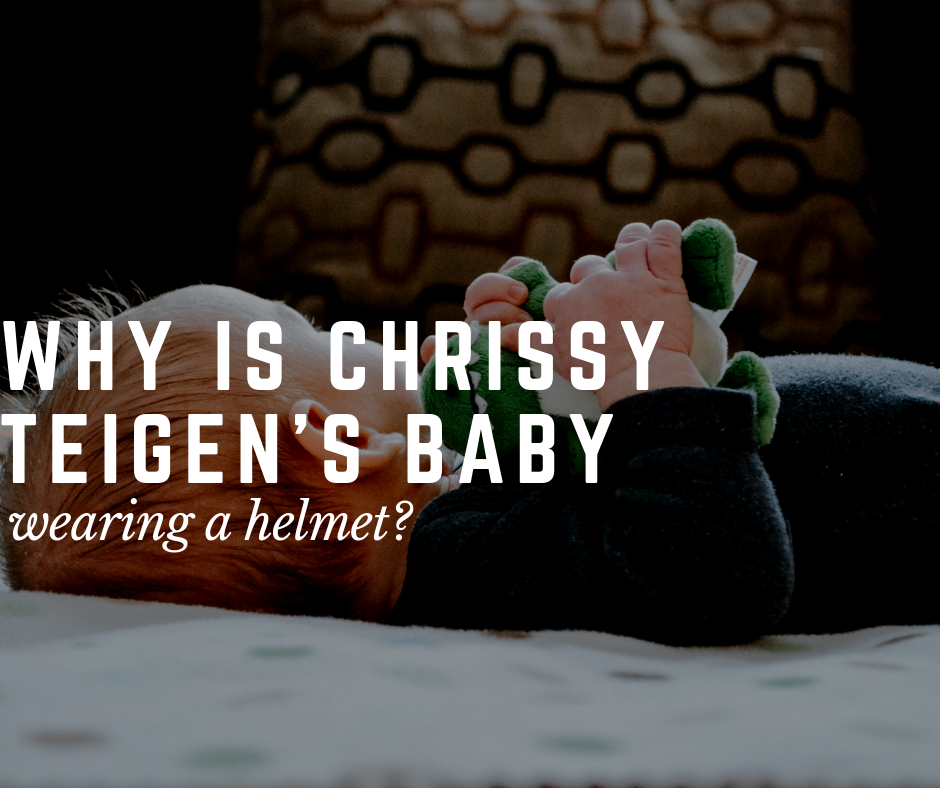Why Is Chrissy Teigen’s Baby Wearing A Helmet?
Chrissy Teigen tweeted on December 3, 2018:
“baby miles getting fitted for a little helmet today for his adorable slightly misshapen head. so if you see pictures, don’t feel bad for him because he’s just fixing his flat and honestly he’s probably gonna be even cuter with it somehow.”
Do you relate to Chrissy Teigen’s story about her cutie pie wearing a baby helmet? Chances are that you have seen many babies wearing a helmet and maybe you have wondered what the helmet does and why they wear it. Here’s the explanation.
It is simply a case of Anatomy meets Gravity.
Anatomy
A newborn’s skull has to be strong enough to protect the human’s most important and complex organ, the brain, although flexible enough to get out of a Mama’s small opening. The skull doesn’t immediately harden up with the baby’s first breath. The process of the skull plates coming together and hardening takes many months – about 18 months for most babies to be exact. The baby’s head is softest just after birth and therefore most easily influenced by Gravity. . .
Gravity
Unless we move to the moon, a strong gravitational force is constantly pushing our bodies onto whatever surface our body rests. When a baby’s soft skull is consistently resting on the same surface or in the same position, Gravity will push the skull to take the shape of that surface. This shape transformation happens quickly and is often noticeable by 6-8 weeks of age. Babies born prematurely have softer skulls than full term babies and are at a higher risk of head flattening.
Types of head flattening
The medical terminology for the two most common types of head flattening are brachycephaly and plagiocephaly.
Brachycephaly is where the baby’s head is flattened symmetrically across the back of the head. This typically leads to the back of the head being higher than the forehead because the baby has been lying most frequently in an angled baby container (e.g. swing, bouncer, rocker) and gravity has forced the lower part of the skull to spread upwards and outwards.
Plagiocephaly is where the baby’s head is flatter on one side than the other. Depending on the severity of the head flattening, one ear can be more forward than the other and other asymmetries may occur in the forehead, eyes and cheekbones. Plagiocephaly is most commonly associated with torticollis/tortisoma, whereby the baby has tightening in the neck/body causing the baby to tilt their head to one side and look more frequently in the opposite direction. The baby may also consistently lean to one side or be able to roll in one direction but not the other. Evidence suggests that torticollis/tortisoma requires immediate treatment in effort to have the best outcome in shortest amount of time possible. As a pediatric physical therapist, I’m always very happy when these babies are referred to me for treatment by two months of age.
Now that we have the science behind head flattening explained, let’s dispel a few myths about head flattening.
1) Myth #1. Babies with head flattening have been neglected by their parents and caregivers. INCORRECT
As we just discussed, this transformation occurs quickly! A lot is happening in the lives of parents with a new baby, and the last thing they need is others’ judgment. American baby registries and showers can be OTT and this often leads to babies having access to multiple “baby containers” (e.g. swings, infant seats, click-and-carry car seats, rock-n-plays, etc). The babies with head flattening have typically not been neglected at all. They have simply spent more time in a “baby container” than in other positions such as on the tummy, in sidelying, in arms or in a babywearing device. Hence, Mr. Gravity has pushed the back of the baby’s skull into the supporting surface and the skull has changed shape as a result.
2) Myth #2. Head flattening is genetic. INCORRECT.
If you look at adults older than 30 years old, you will be hard-pressed to find a head that is flat in the back. Why is this? Three things: 1) Unbalanced use of modern baby equipment, 2) the advent of mandatory car seat laws, and 3) the “Back to Sleep” campaign. While I suggest that you consider decreasing or eliminating the use of baby containers in the home, please, please, please do not take this as a reason to stop using a car seat or to start sleeping your infant on their stomach or side. Research is very clear that both car seat use and back sleeping have proved effective in decreasing infant deaths.
The take away is that while most babies sleep on their back and use car seats daily, only some babies have head flattening. Why? It’s not genetics. It’s a question of balance. The babies with head flattening have simply had more time lying on their back (often strapped in at an angle) in comparison to other positions. Babies with rounded heads have had more of a balance in multiple positions throughout their day. This is the reason why the “Back to Sleep” campaign of the 90s has evolved into the current “Back to Sleep, Tummy to Play” campaign to make caregivers aware of the importance of tummy time during awake periods.
3) Myth #3. The baby’s head will round out as they age. LET’S DISCUSS.
In my experience as a pediatric physical therapist, I have seen babies’ heads become rounder without a helmet only under the following circumstances:
- The head flattening is very mild,
- environmental changes and positioning modifications have gone into place before 3 months of age,
- the parents/caregivers have immediately stopped using all “baby containers” with the exception of car seats while in the car, and
- any other orthopedic (e.g. neck/body asymmetry and tightening) and developmental concerns are being proactively and promptly addressed.
So, what can be done if a baby’s head is flat?
You can talk to your pediatrician about any head flattening that you notice as soon as you notice it. It will be a more efficient and effective treatment solution for your baby the sooner that your baby begins any necessary corrective measures. This is particularly true if you are noticing more flattening on one side of the head, which typically indicates that the baby needs physical therapy ASAP to address muscle tightness/imbalance and movement asymmetry. Most babies with either type of head flattening can also benefit from more positional changes and tummy time in order to ensure that the muscles on the back of the body are getting enough strengthening opportunities.
While I don’t know if Chrissy Teigen received advice about positioning her cutie pie and making environmental changes (I’m totally here for you, Chrissy, if not.), I do know that she took the step to get a helmet for her baby.
What will a “baby helmet” do for the baby?
The helmet is hard on the outside and foam-filled on the inside. It is specifically molded to place a restriction on the edges of the Baby Teigen’s flat spot while leaving space for the skull to round out where the head needs to round out. Per protocol, Baby Miles will likely be wearing it 23 hours per day and hence you may see lots of photos of the adorable Miles out and about in his new helmet.
In general, the length of time that the baby needs to wear the device depends on the age that the baby begins treatment and the severity of the head flattening. Most babies wear the helmet for at least eight weeks with weekly visits to the orthotist or occupational therapist for adjustments to the inside foam mold because the baby’s head shape will change quickly.
Is a “baby helmet” covered by insurance?
A “baby helmet” is known as a “cranial orthosis” in the medical world. So, if you are trying to find out if your insurance company will pay for one, “cranial orthosis” is the term that you can use. Cranial orthoses cost over $2,000 and not all insurance plans cover them. Herein is another reason why you should be sending your friend who has a baby in a helmet some understanding instead of judgment. They may have just dipped into savings for this medical intervention. Be kind always.
When should a baby get evaluated to see if they need a cranial orthosis?
The occupational therapists that evaluate babies for cranial orthoses at Cranial Technologies in Austin recommend that the ideal time to begin intervention is 4-6 months of age. As the baby gets closer to one year old, the skull plates come together and begin to solidify in the shape that they currently are in. After the soft spot closes around 18 months of age, the head will get larger and retain the same shape as the child grows.
If your baby’s head flattening is a concern of yours, rest-assured that there are medical professionals available to see if your baby could benefit from corrective measures. Know that you are not alone and that there are answers to your questions.










